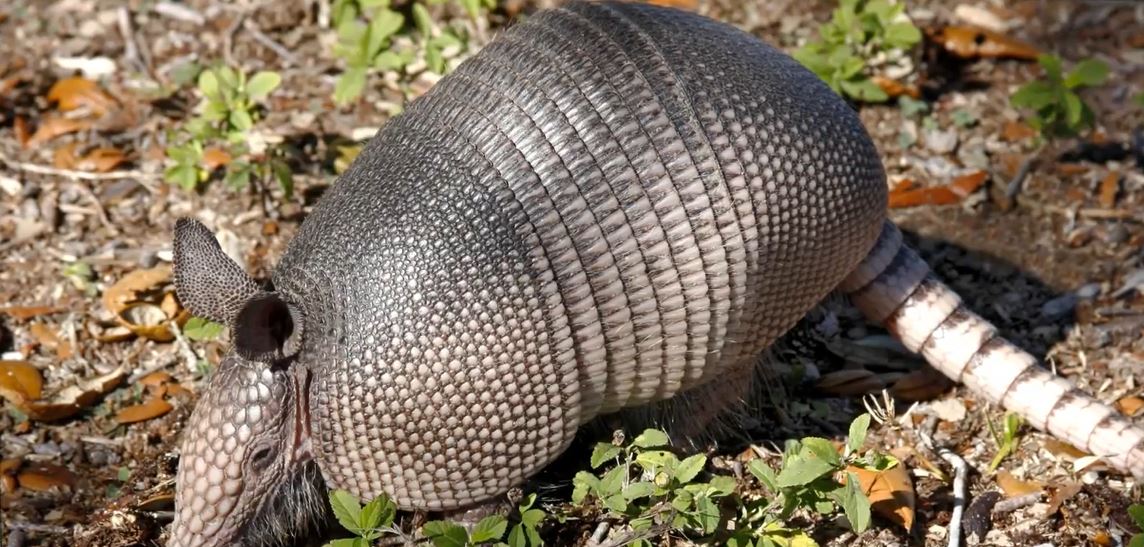About Armadillos: Appearance, biology, life cycle, habitat, diet, behavior

Armadillos are curious-looking creatures. With their brownish-gray, leathery-armor plating, there is nothing quite like them anywhere on the planet. They are mammals, of the order Cingulata, and part of the superorder Xenarthra. Sloths and anteaters also belong to this superorder. In Spanish, armadillo means “little armored one.”
Origin and Variety
There are several varieties of armadillos, including the giant armadillo, which grows to 59 inches long and weighs up to 119 lbs. The pink fairy armadillo is only five or six inches long. The three-banded armadillo in South America is the only one able to roll up into a ball. The others have too many bands to be able to roll up.
Habitat
Armadillos originated in South America, but have made their way up through Central America and into the United States. Armadillos prefer a warm, rainy climate, but will settle for open prairie, scrubland, or tropical rainforest. They don't do well in cold or dry climates.
The nine-banded armadillo, the one common in the south-central states, especially Texas, but can range as far east as South Carolina and Florida, and as far north as Nebraska, southern Indiana, and southern Illinois. Armadillos can be seen in Louisiana, Alabama, Mississippi, and Arkansas, as well as in Kansas, Missouri, Tennessee, and Georgia. In late 2009, when they began appearing in southern North Carolina, state officials considered establishing a hunting season for them. Armadillos continue to push their way farther north, east, and west. They are expected to range as far north as Ohio, Pennsylvania, New Jersey, and Connecticut.
Reproduction
North American nine-banded armadillo females give birth to four identical quadruplets eight months after mating. Mating takes place in July and August. But the single fertilized egg is not implanted for three or four months to ensure the babies are not born during the winter. The actual gestation period is four months. The babies are born with soft, leathery skin, which hardens within just a few weeks. These babies nurse their mother for three months before leaving the nest and learning to forage with her. The nine-banded armadillo becomes sexually mature at one year of age. They live 12–15 years. A single female can give birth to 56 babies in her lifetime.
Behavior
Armadillos like to burrow into cool, soft dirt to make their home. Their long claws make perfect digging tools. One armadillo will dig out several tunnels that can each be up to twenty-five feet long. They are loners and don't share their burrows with anyone else. They are nocturnal animals, so only come out to forage at night. Not only do they burrow to make a home for themselves, they also dig up the ground in search of grubs, worms, and insects.
Their digging can damage lawns, gardens, and tree roots. Therefore, most people do not appreciate having armadillos live on their property. However, there are some people in Texas who raise armadillos for armadillo racing. This small, but well-established sport sends the racers down a 40-foot racetrack.
Armadillos have very poor eyesight. They can be frightened, especially by vehicles driving by. They are capable of jumping three to four feet straight up in the air when startled. They are common roadkill due to their poor eyesight and their habit of roaming at night.
Diet
Nine-banded armadillos, the ones common in the United States, live on grubs and worms with some ants, termites, and beetles thrown in for good measure. They root around in the soil with their long noses, digging and loosening up the soil to flush out the bugs. They lap up the bugs with their sticky tongues. They also will eat amphibians and small reptiles, especially during the winter when they are easier to catch. They have been known to eat bird eggs and baby mammals. Armadillos will eat carrion, also, but perhaps more for the maggots than for the flesh of the dead animal.
Prey and Predators
Armadillos are hunted for their meat, which is said to taste like pork. During the Depression, those who blamed President Herbert Hoover for the Depression referred them to as “Hoover Hogs.” The meat was also called “poor man's pork.”
Predators of the armadillo will have a difficult time catching one. They are surprisingly fast, but if the predator catches up to it, it will quickly dig out a trench and hunker down in it. Due to its protective armor, a predator can rarely dislodge it from its refuge. Predators include the cougar, maned wolf, red wolf, bobcat, jaguar, coyote, alligator, and raptors. Juveniles are easier prey because their armor hasn't yet hardened completely and they tend to forage earlier in the afternoon. However, humans are by far the armadillo's greatest predator. They are hunted for their meat and shells, and are frequent victims on the roadways.
Read the How to get rid of armadillos page for helpful information and to learn more about About Armadillos: Appearance, biology, life cycle, habitat, diet, behavior

